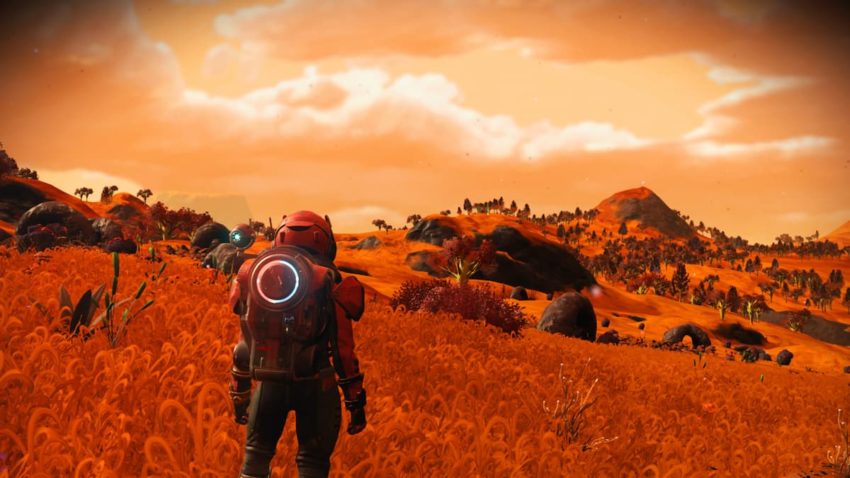Guide to Planet Types in No Man's Sky
While you lot're cruising around in No Man's Sky's version of infinite, yous'll run into plenty of planets that need exploring and to be mined for all their valuable natural resource. The different types of planets in No Human being's Heaven have inverse a bit since the game has launched, with new categories being introduced over time. If yous're wondering what to expect equally you explore the stars, nosotros've got everything you lot need to know about the worlds waiting for you out there.
Planets in No Man's Heaven are sorted into categories called Biomes. Every world y'all encounter will fit into one of these Biomes, though not every globe in a Biome will exist identical so information technology is still worth exploring even when you're looking for a specific planet blazon.
Lush Biomes

These are typically your Earth-like planets, with grass and plants covering about of the surface. At that place may or may not exist copse nowadays, either in thin growths or dense forests. Lush planets volition, unsurprisingly, take the most diverse animal life in the universe.
Resource mutual in Lush Biomes are:
- Paraffinium
- Star Bulb
- Nitrogen
Arid Biomes

Almost the exact opposite of Lush planets, Barren Biomes are largely desert planets. They have very petty water, and then their institute and fauna resources will be limited. They tend to have rocky terrain with the occasional ravine or canyon present on their surface. Most of their planet life will exist limited and small.
Resources common in Barren Biomes are:
- Pyrite
- Cactus Mankind
- Sulphurine
Dead Biomes

As expected from the title, these are planets devoid of life. Dead planets have no atmosphere, depression gravity, and trivial if any constitute or animal life. These harsh planets volition bleed your life support systems every bit you explore them, so bring plenty of resources if yous do desire to make your style beyond their surface.
Resources common on Expressionless Biomes are:
- Rusted Metal
Exotic Biomes

These planets look similar to Dead Biomes when viewed from space, but will occasionally take a foreign, bogus Hex construction along their surface. These are rare planets that have express atmosphere and gravity just won't strain your life support systems more than than other Biomes. Exploring them will sometimes reveal unique structures and vacant bases. As of the Visions update, Exotic Biomes each have a single Stabilised Reality Glitch to notice.
Resources mutual on Exotic Biomes are:
- Gilded
Scorched Biomes

These planets are exactly every bit they sound. They have unusually loftier temperatures which make them difficult to explore, but they tin can also be filled with unusual institute life. Occasionally, y'all'll come up across plants on a Scorched planet that has adapted to the farthermost environment by being filled with boiling liquid. You lot will need to take Thermal Protection to stay here long.
Resource common on Scorched Biomes are:
- Phosphorus
- Solanium
- Sulphurine
Frozen Biomes

At the other finish of the scale from Scorched Biomes are Frozen planets. These worlds can still accept constitute and creature life, with copse roofing much of the planet's surface. You will still need to take Thermal Protection to spend much time on these worlds.
Resources common on Frozen Biomes are:
- Dioxite
- Frost Crystal
- Radon
Toxic Biomes

These worlds are harsh places to explore with toxic rain falling almost constantly and rivers of poisonous liquid running beyond its surface. There is oft flora on these planets, ordinarily in the form of mushrooms and strange, dangerous plants. There will rarely be animal life on these worlds and yous will demand to take Toxic Protection upgrades to spend much time here.
Resources common on Toxic Biomes are:
- Ammonia
- Fungal Mould
- Nitrogen
Irradiated Biomes
These worlds are filled with radioactive gases and materials, resulting in highly mutated plants. Irradiated Biomes normally accept animals on their surface, merely very little h2o or breathable temper. Unsurprisingly, you'll need Radiation Protection upgrades to spend a decent corporeality of time on these planets.
Resources common on Irradiated Biomes are:
- Uranium
- Gamma Root
- Radon
Marsh Biomes
These planets are similar to Lush Biomes except that they tin be much more dangerous. Their surfaces are often covered in a strange mist when viewed from space and they are home to fungi and toxic planets. Virtually Marsh Biomes will accept a source of h2o on them likewise as big tree stumps littered around their surface.
Resources common on Marsh Biomes are:
- Faecium
- Mordite
Volcanic Biomes
These worlds have an unstable surface, with volcanic eruptions common across the planet. They are difficult to explore for the same reason that Scorched Biomes are, with the added danger of random explosions happening around yous equally you walk effectually. You'll need a Coolant Network upgrade to spend much time here.
There are no resources common beyond all Volcanic Biomes.
Mega Exotic Biomes
These are similar to the Exotic Biomes described above, except everything is plus-sized. Look to find huge versions of plants and animals, a strange red hue to the skies, and unusual rock formations scattered around. Mega Exotic Biomes have an atmosphere just tin can be inhospitable places to land.
Resources common on Mega Exotic Biomes are:
- Water
Source: https://www.gamepur.com/guides/guide-to-planet-types-in-no-mans-sky
Posted by: reamurper.blogspot.com


0 Response to "Guide to Planet Types in No Man's Sky"
Post a Comment